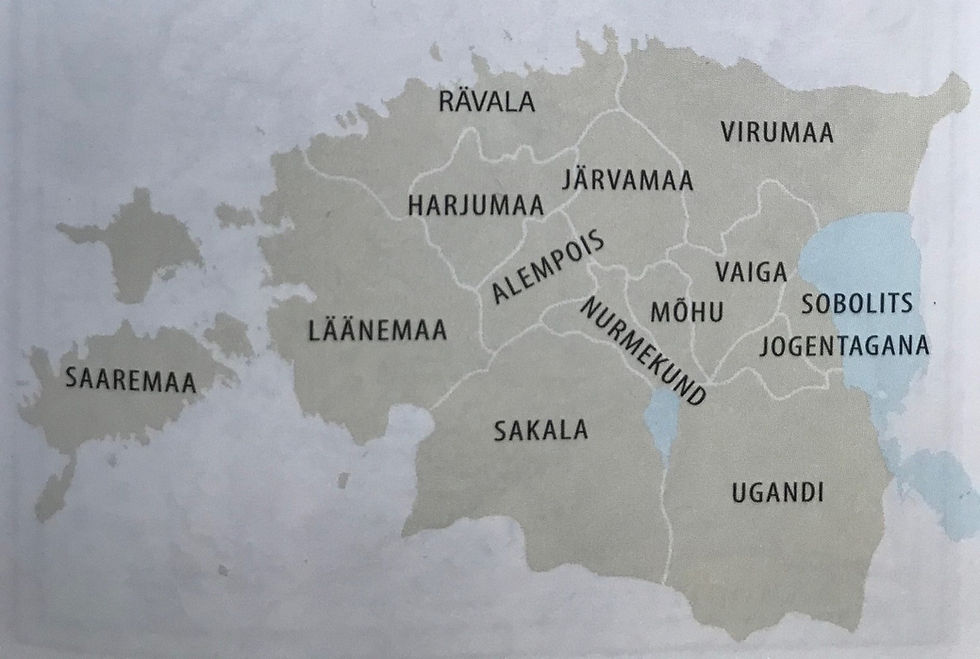A warming climate, a Pope in difficulty, and a boy born Temujin in 1162 figured among key events - to my mind - that ended millennia of Estonians quietly going about their business.
A book a friend gave me, Eesti omavalitsuste taskuentsüklopeedia, portrays the Finno-Ugric peoples living in the Baltic at the dawn of the 1200s as a dozen or so clan-based territorial units. They were hunting, farming, fishing peoples speaking closely-related dialects, and sharing a common culture.
Territorial division in Estonia at the dawn of the 13th Century, before foreign conquest
This form of self-government ended after 1208 when German-speaking crusaders of the north stormed the hilltop fortress of Otepää in southern Estonia, and in 1219 when Danish invaders completed their conquest of the northern coastal strip.
So, why would a self-governing military order and latter-day Vikings bother with a region lacking in minerals, short on people, not known for amber, unprosperous in fur trapping, in short, devoid of anything worth plundering?
A Pope-inspired crusading zeal seems to be the answer, an excuse to murder and despoil others, while remaining holy and pious.
At any rate, foreigners invaded Estonian territory in the early 1200s, and its indigenous inhabitants disappeared from history, working the land as peasants and serfs for their new overlords, holding onto their language and their culture, as the tides of war swirled around them over the centuries.
Terror from the east
Temujin grew up to learn his great-grandfather died a great leader of the Central Asian steppes, only for his son to be tortured to death, and his grandson poisoned, leaving his descendants “with no friends other than our shadows”. Temujin found allies and avenged his family’s oppressors, with great violence, and successfully against the odds, and he didn’t stop.
Genghis Khan once said of his way of life, “The greatest pleasure for a man is to crush a rebel, and defeat his enemy, destroy him, taking everything he possesses” and more of this sort of self-congratulation, a psychopath to beat all others, well described in Simon Sebag Montefiore’s 2022 masterpiece, The World: a family history.
After Genghis (the Fierce) died in 1227 his sons and daughters, and their grandchildren, unleashed a storm of conquest south and west, arriving in the Rurikovitch capital of Kyiv within a decade. Then followed the rise and expansion of shrewd and dogged survivors of conflict, later known as Russians, starting with Alexander Nevsky, a local strongman and agent for the Mongols, who defeated the German-speaking Livonian Order on a frozen Estonian lake, the peipsijärv, in 1242.
Russia never looked back on centuries of defeats and conquests. The last of the Rurikovitch dynasty, Ivan IV, the Terrible, destroyed the Livonian Order in a bitter war in the mid-1500s that saw a halving of Estonia’s population. The Russians came into a land that was not their own, and have been a threat ever since.
As to the influence of the climate, warmer times from the 1000s onwards led to rising agrarian populations throughout Europe, and a glut of landless second and younger sons, not all of whom could become priests. Such were fitted for war, and on 27 November 1095 Pope Urban II provided a just cause.
The man formerly known as Odo of Châtillon held a council of notables in Clermont, Auvergne, in what is now France, and called upon Western Christendom to “destroy that vile race [of Turks and to] enter upon that road to the Holy Sepulchre, and subject it to yourselves for the remissions of sins, with the assurance of the imperishable Kingdom of Heaven.”
The Pope who had a rival in a German anti-pope to contend with, and a request for aid from his Byzantine counterpart, could hardly have imagined what he unleashed in following centuries, in the distant Levant, spreading through the known world, reaching, ultimately, as far as Estonia.
There seems to be no cure for those who repeat history – other than, perhaps, to remember the past, accept it, move on, and break the chain of violence and oppression.

Comments